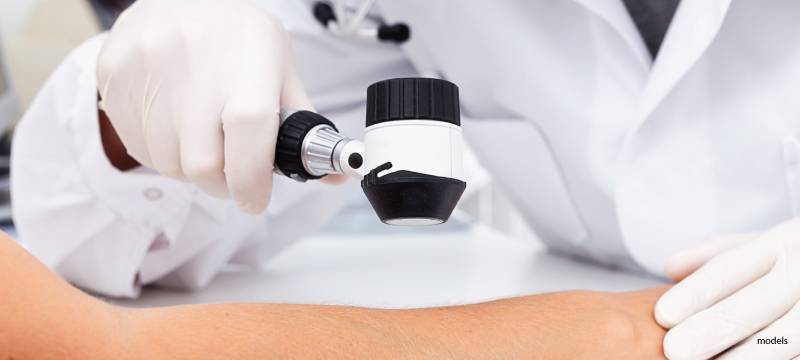What Happens During A Skin Cancer Screening?

Originally Published February 2, 2016. Updated April 7, 2022 with additional information.
It’s estimated that nearly 1-in-5 Americans will be affected by some form of skin cancer during their lifetime. In fact, more than one million people are diagnosed with skin cancer each year. While skin cancer can affect people of all different skin types and skin colors, the risk of development can be greater if your parent, sibling or child has had a melanoma.
Early diagnosis is the key. Typically skin cancer that is discovered and removed early is highly curable. As such, regular self-examination is a powerful tool which can alert you to changes in your skin. A change in a mole can indicate a serious problem. Your dermatologist should be seen if you notice that a mole becomes larger, changes color, is asymmetric, or develops an irregular border. Other warning signs include itching, crusting, pain, and bleeding.
While monthly self-examination is great, getting a yearly professional skin check is highly recommended. Trained dermatologists are more able to detect cancerous symptoms early. Here are answers to some frequently asked questions concerning yearly cancer screenings:
Why Skin Cancer Screenings Are Important
In the United States alone, 1 in 5 people will develop skin cancer. Melanoma, the most serious type of skin cancer, can occur in areas that haven’t been exposed to the sun. When it occurs on the back of the body, it’s not always visible.
Early detection is key. Of the 60,000+ people who get diagnosed in the US from melanoma each year, 9,000 will die. By identifying skin cancer before it becomes life threatening, you are potentially saving your own life.
Who Should Get Examined?
Everyone should have annual skin cancer exams, although some people are more susceptible to skin cancer than others. If any of the following are true, you should be especially vigilant about annual exams in addition to daily sun protection.
- A close relative has had melanoma
- You have a history of precancerous lesions or skin cancer
- You have a large number of moles or 1 or more atypical moles
- You’ve used tanning beds in the past
- You tend to burn when in the sun
- You’ve had regular, ample sun exposure throughout your life
- You’re an organ transplant recipient
How Often Should a Skin Check Be Performed?
Annual exams are recommended. This gives your dermatologist the opportunity to track changes to existing moles and to look for new areas of concern.
To remember your appointment, schedule it near your birthday, the first of the year, or around another memorable, annual event.
How to Prepare for Your Annual Skin Exam
The following tips will help you get the most out of your annual skin exam appointment:
- Do a self-check first: In front of a mirror, look for any spots that have recently changed in shape or size, are irregular or asymmetrically shaped, are bleeding, seem not to heal, or are larger than a pencil eraser. Report what you find to your doctor.
- Prepare questions: Your annual exam is a good opportunity to ask your dermatologist about self-checks, anything that’s been concerning you, or how to cosmetically treat non-cancerous lesions.
- Remove nail and toe polish: Skin cancer can develop on your nail beds. Going without polish lets your doctor examine your hands and feet.
- Let your hair down: Skin cancers often develop on the scalp. Wearing a loose hair style makes it easier for your doctor to examine your head.
- Skip the makeup: Your doctor may use a special instrument called a dermatoscope to look closely at the skin on your face. If you’re wearing make-up, it will need to be removed.
In addition, remove jewelry, band aids, bandages and anything else that might cover your skin.
What to Expect During a Full Body Skin Check
A skin cancer screening is a full body skin check. Your doctor will examine the top of your head, all the way down to the bottom of your feet for any moles, growths or spots that look suspicious. The following will give you an idea of what to expect.
- How Long Does It Take? If you’ve never before had skin cancer or irregular moles, the procedure should be relatively quick, taking less than 15 minutes. If you have a personal history of cancer or several moles, expect it to take slightly longer.
- Do I Get Undressed? You’ll be asked to remove all of your clothes and put on a gown. It’s important your doctor sees all areas of your skin, including your back, buttocks and even between your toes.
- What Tools are Used? Your dermatologist will check your skin, sometimes using a dermatoscope to view irregularities unseen by the eye alone. She or he will likely spend more time in hard-to-see areas such as your scalp, behind your ears and on your back.
- What Documentation is Taken? Your doctor might document some spots by taking notes or using photographs, to better detect and track change at your next appointment.
How long does the annual screening take?
While most skin cancer screenings take about 10 minutes, the exact time of your screening will depend on how many moles you have.
What Happens if Your Doctor Finds Something Suspicious?
If your dermatologist finds a spot that appears it could be precancerous, a biopsy will be performed. This procedure is relatively quick, and can take place in office at your screening appointment.
First, your doctor will clean the area and numb the site with anesthesia. Then, they’ll take a small scraping of skin and either review it themselves, or send it to a lab for closer inspection.
If the sample turns out to be cancerous, your doctor will inform you of your treatment options. Skin cancer that’s detected early is relatively easy and inexpensive to treat, which is the primary benefit of annual skin cancer exams.
Is annual skin cancer screening covered by medical insurance?
Most insurance carriers will cover annual skin cancer checks, paying all or part of the total cost. Please visit our insurance page to learn which plans we currently accept.

Would an annual skin check be covered under most health insurances?
It’s good to know about professional skin checks. I had no idea that literally everyone should get one of these each year. My family hasn’t seen a skin doctor in who knows how long, so I’ll try to remedy that.
Skin cancer runs in my family so I have recently been thinking about getting my skin looked at to make sure that I don’t have skin cancer. I really appreciated how it talked about how the screenings take about 10 minutes. That is good to know that it won’t be a very long process So I will make sure to plan accordingly.
It is interesting that you recommend a yearly dermatology visit. I had never heard that before. Skin cancer runs in my family, so I’ll start doing that.
Wow, it really helped when you described why we should take a skin exam at least once a year. Last week, I found out that my grandfather had cancer, so I started thinking about how my dad and I could be prone to develop it too. I believe that it’d be wise if my dad and I looked for a dermatologist to help us, so we’ll look into it. Thank you for the advice on how we could detect skin cancer on time and treat it.